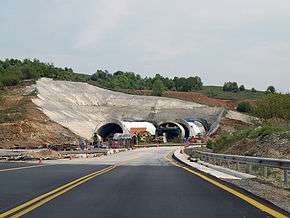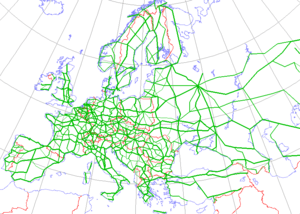European route E79
| |
|---|---|
 | |
| Route information | |
| Length | 1,300 km (800 mi) |
| Major junctions | |
| North end | Miskolc, Hungary |
| South end | Thessaloniki, Greece |
| Location | |
| Countries |
|
| Highway system | |
| International E-road network | |



European route E 79 is a road part of the International E-road network. It begins in Miskolc, Hungary and ends in Thessaloniki, Greece, also running through Romania and Bulgaria. The road is 1,300 km (810 mi) long.
Itinerary
The E 79 routes through four European countries:
_Otszogletu_kek_tabla.svg.png)

_Otszogletu_kek_tabla.svg.png)

_Otszogletu_kek_tabla.svg.png)

_Otszogletu_zold_tabla.svg.png)













- Sofia Northern Bypass (






Route description
Hungary
The Hungarian section of E79 shares parts of its path with other E-roads, such as E60, E573 and E71.[1]
Romania
The Romanian section of the road is partly under construction (20 km in bad condition, on the section Oradea-Deva), as can be seen on the map with Romanian road quality.[2] Although only in the region of 500 km (310 mi) the road itself is single carriageway except in major towns. With little or no room for overtaking, a 50 km/h (31 mph) restriction when passing through the many minor villages, and a great number of slow vehicles, the average speed is generally in the low 50 km/h range.
Since 2012, work has begun to improve the quality of this road:
- A. Oradea – Deva (Șoimuș) [under construction on approx. 40% of its length]: For the moment there are better routes, but passage is possible (drive carefully, especially during the night or in bad weather conditions, as many safety elements may be missing). Parts of the road are under construction, while other parts have been finished and are good (some excellent). Expect some bumps in the road, traffic lights and delays. The repairs are in very poor state on a mountainous section of about 20 km between Vașcău and Vârfurile, where the contract for repairs was cancelled; the National road company has refurbished the asphalt in this mountain region in the autumn of 2016, but the section is bumpy (no potholes, just bumps). Repairs are still underway and will be scaled up in 2018.
Contracts were signed in late 2012 to improve this section. Status of work progress is December 2017, by section, North to South:
- Oradea-Beiuș (cca. 60 km): The national company has refurbished the asphalt (done, asphalt is decent but not new). Initial constructor was the joint venture CCCF Drumuri și Poduri Timișoara–CO.GE.FA S.p.A.–Simco SRL, but the contract was cancelled (the constructor had financial problems; contract value: 36.6 million euro (contract 5R10a). Work for complete rehabilitation is expected to start in 2018, with an auction, on FEDR funding from the European Union [3].
- Beiuș-Ștei (cca. 28 km): AZVI/AZCALE (cca. 100 mil. RON without VAT, contract 5R13, progress in December 2016: >90%). [4]
The portion Ștei-Ionești (50km) is still under construction and while some parts are redone, very bad road conditions can also be found. We suggest avoiding this road until works are finished (2019-2020).
- Ștei-Vârfurile (cca. 33 km): SC Antreprenor Construct Mod SRL (progress status: 70% in December 2016). - Some parts rehabilitated, but towards Vârfurile (the highest point of the road between Oradea and Deva) the road becomes very bad, with no asphalt at all (status - December 2017).
- Vârfurile-Ionești (cca. 14 km): Narrow, old road, with poor asphalt. Original contractor was VIALES Y OBRAS PUBLICAS (cca. 43 mil RON without VAT, contract 5R11, progress in 2015: 29.76%). Contract cancelled in September 2015. Re-auctioned recently. Auction won by SC SYLC CON TRANS SRL / HIDROSTROY AD --- 55.945.649,16 RON without VAT. The auction can still be contested. The official deadline for building this section is 12 months.source
Starting with Ionești, the road is good until as far south as Calafat (400 km), with only very small portions still under construction.
- Ionești-Brad (cca. 20 km): PORR (cca. 65 mil. RON without VAT, contract 5R10b, 100% finished in December 2017).
- Șoimuș-Brad (cca. 30 km): SELINA (105 mil. RON without VAT, contract 5R10a, progress status in December 2017 - 100% - section accepted as completed by the national road company).
Initial financing sources for all contracts was: 50% from the state budget, 50% loaned from the European Investment Bank. On 4 December 2013, the Romanian Ministry for European Funds included this project on the list of infrastructure projects financed by the EU. The Ministry sent to the European Commission a request to evaluate the financing of this sector, for a total of 210 million Euro (of which 142 million Euro from the EU through the ERDF mechanism).[5]
- B. Deva – Petroșani [good, done]: The road has been significantly improved in the last years, being widened and having excellent asphalt quality on the entire section of the road (construction finished in 2012).
- C. Petroșani – Bumbești Jiu [good, small part still under construction - less than 1 km]: This section should be considered as good. Conditions have improved in late 2017 [6] (due to rehabilitation work done by Copisa Constructora Pirenaica–Chirulli Andrea Impresa Individuale–Coremi Inter joint venture - 34 mil. euro contract, signed on 29 June 2012). On 29 November 2013, the Romanian Ministry for European Funds sent to the European Commission a request to evaluate the financing of this sector, for a total of 396 million Euro (of which 288 eligible for EU funds, of which 244 million Euro from the EU through the ERDF mechanism).[7] Works on this section were expected to take around two years, and were expected to be finished by the end of 2014. In December 2016, the section was still under construction on about 40% of its length. It is currently almost completely rehabilitated, with very good asphalt and jersey blocks to prevent fall into the valley. A small part of the road (less than 1 km), near an old monastery (Lainici), is still under construction (as several variants were considered to move traffic away from the building). 2 bridges over the river Jiu are still under construction (Lainici and Bumbești),but will most likely be finished during 2018.
- D. Bumbești Jiu – Craiova [good, minor construction work]: The section Bumbești Jiu – Rovinari is in good condition, almost completely rehabilitated (rehabilitation work by Asocierea Comsa S.A.U. - Corporate Management Solution SRL, 117 mil. RON, 85% FEDR + 15% National funds, 90% done in January 2016 according to the national roads company [8]). The section Rovinari - Filiasi has been repaired in 2010, by FCC Construccion, and is currently in good condition. The section Filiași – Craiova is part of the DN6 road and is in good condition, also being repaired in 2010.
- E. Craiova – Calafat [good, almost done, cca. 95%]: In december 2017, the 2 sub-sections (Craiova-Galicea Mare, Galicea Mare-Calafat) are 92%, and 98% done [9]. On 6 December 2013, the Romanian Ministry for European Funds sent to the European Commission a request to evaluate the financing of this sector, for a total of 73 million Euro (of which 47 million Euro from the EU through the ERDF mechanism).[10]
Bulgaria
The Bulgarian section of E79 spans nearly 400 km (250 mi) from the North Bulgarian city of Vidin, connecting the Calafat–Vidin Bridge (or, alternatively, the Vidin-Calafat ferry line) across the Danube River and straight southwards towards Bulgaria's capital Sofia. The road has moderately good surface, it is constantly maintained and repaired and well signed with directing signs in Bulgarian and in English. Most of the length from Vidin to Botevgrad, the road is two-lane tarmac road following the natural relief of the landscape. There are sections where 3 lanes for overtaking slow-moving traffic are available. Rest stops and parking spots near the road are also available. The Bulgarian Traffic law prescribes a 50 km/h (31 mph) in most residential areas coinciding with the route of the road and not more than 90 km/h (56 mph) on the section of the road outside living areas. There are plans to upgrade Vidin-Botevgrad road to a grade separated expressway (close to motorway standard), allowing speeds up to 140 km/h (87 mph).
From Botevgrad to Sofia, E79 joins Hemus motorway, designated A2. At the Bulgarian capital Sofia you have to enter the Ring Road, until Sofia Northern Bypass motorway is built. Signage is available. From Sofia to south there are 52 km (32 mi) of motorways (A6 Lyulin motorway and A3 Struma motorway) to Dupnitsa-north interchange. The Bulgarian Traffic law allows speeds up to 140 km/h (87 mph) on motorways unless otherwise stated. The road is leading from Dolna Dikanya to south, right to the Kulata-Promachonas. All the way to the Border Check point the road is of the standard 2-lane tarmac except for the section from the Pernik Province-Blagoevgrad Province border and the southern entrance to the city of Blagoevgrad where the road is of highway type and is 8 km (5.0 mi) long. The section between Dupnitsa and Blagoevgrad, 37 km long, has been upgraded to a motorway standard and opened to traffic 2015. Also the last of these sections - lot 4 from Sandanski-south to the Greek border of 13 km opened to traffic in August 2015. The stretch between Blagoevgrad and Sandanski - lot 3 - passes through the Kresna Gorge and is planned to feature a 13.3 km (8.3 mi) tunnel, which will be the longest motorway tunnel in Eastern Europe, whose construction will begin in 2015 and will cost app. EUR 650 mln.
There are no restriction to trucks driving in the weekends (except when temps rise above 38 °C (100 °F)) so they pose additional road hazard particularly high when driving at night. Traffic is usually heavy in weekends and overtaking has to be done swiftly and without risk, minding the other participants in the traffic.
At night, motorcyclists are required (and that is strongly advisable for their own safety) to use high-visibility vests.
Greece
The Greek Section of E79 has a length of about 120 km (75 mi). After crossing the Bulgarian-Greek border entering into Greece, the road drastically improves as it has been upgraded to a motorway; and speeds of up to 120 km/h (75 mph) are common. After the Promachonas Border Checkpoint, there is a section in construction, about 20–30 km. After that the new 3 lane motorway is well managed, repaired and policed up to the city of Loutra Serron. Construction and upgrading works are still continuing near Serres (due to state budget cuts, works are not scheduled to complete before 2015). After Serres the 3 lane motorway continues for a further 60 km (37 mi) and finally ends at a large junction with the A2/E90, which then provides direct access with Thessaloniki's Ring Road motorway and onto Chalkidiki, for travellers heading south.
References
- ↑ http://www.unece.org/fileadmin/DAM/trans/conventn/ECE-TRANS-SC1-384e.pdf
- ↑ http://forum.peundemerg.ro/index.php?topic=199.0
- ↑ "Au semnat pentru faza a II-a a reabilitării şoselei Oradea - Deva. Finanţare de aproape 591 milioane de lei - BihorStiri.ro". BihorStiri.ro (in Romanian). 2017-08-28. Retrieved 2018-01-04.
- ↑ "Drumul National 76". www.facebook.com. Retrieved 2018-01-04.
- ↑ http://www.fonduri-ue.ro/comunicare/stiri-am-oi/2289-pos-t
- ↑ http://forum.peundemerg.ro/index.php?topic=12.3015
- ↑ http://www.fonduri-ue.ro/comunicare/stiri-am-oi/2220-pos-t
- ↑ http://cnadnr.ro/img/tabel/STADIULPROIECTELORINDERULARE.pdf
- ↑ "Record ruşinos în infrastructură: Deşi 2017 a fost anul relansării proiectelor de autostrăzi, numai 15 km sunt gata | Ziarul Financiar". www.zf.ro. Retrieved 2018-01-04.
- ↑ http://www.fonduri-ue.ro/comunicare/stiri-am-oi/2287-pos-t

